|
Arthritis, Prostatitis, Diabetes
Viral Infections, Venereal Diseases, Cancer
Pau d'Arco
Lapacho / Taheebo
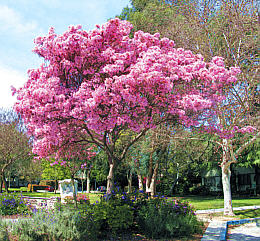
Pau' d Arco
(Handroanthus impetiginosus)
Code BOS285 -- Price: $29.95
120 Capsules x 500 mg.
Code BOS285T -- Price: $12.00
Bag of Tea -- 85g.
Order Now
 Email
Email
 Summarized Description: Summarized Description:
This is another medicinal plant whose classification has produced confusion.
Despite small variations, when referring to Pau d'Arco,
Handroanthus impetiginosus,
Tabebuia impetiginosa, Tabebuia spp., and Bignonia heptaphylla all refer to the
same tree with the same medicinal properties. Similarly, quite a number of common
names are used to identify the tree, the most common being Lapacho and Taheebo,
in addition to Pau d'Arco.
 Pau d'Arco, a large, ornamental canopy tree, has a very long history of
use by indigenous peoples of South America for medicinal purposes, certainly
one that predates the Incas.
Uses & Protocols
 Pau d'Arco is one of the most revered, widely used
medicinal in the Amazon. It has a long traditional use for the treatment of arthritis (and bursitis),
anemia, boils, colitis, malaria, poor circulation, snake bites, VD, and the broadest range of
cancers of any medicinal herb we've ever worked with. Taylor doesn't recommend its use in capsule
form, but we've seen excellent results using this delivery method. Capsule dosage: two capsules,
two to three times daily. Tea dosage: Prepare as a decoction, using 10 g. (about one-eighth of our 85 g. bag)
to a quart of purified water. Make sure you boil for a good 15 minutes.
Then drink one half to one cup of the tea, two to four times daily.
Warnings & Contraindications
 Not recommended if pregnant, seeking to conceive,
or lactating. Excess dosaging can cause nausea, GI upset, or even vomiting.
Reduce dosage at the first sign of nausea. Do not use higher doses unless under
the advise of qualified practitioner.
Shelf-Life
 Five years or more.
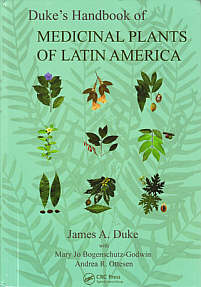
Medicinal Activities
 Further information for practitioners: Further information for practitioners:
World-famous botanist Dr. James Duke attributes the following activities
to this plant (p. 614-617; see hardcopy cover at right),
drawn from the extant literature. (See his graduation for "level of
efficacy" on our amazon traditionals page;
followed by Duke's bibliographic abbreviations (in capital letters),
which we identify
on a separate page.)
 Duke provides a " food farmacy potential" score for this
plant of "FNFF=X."
- Abortifacient (1; MAB; MPG; RAI)
- Alexeritic (f; CRC)
- Analgesic (f; CRC; MAB; RAI; X11574048)
- Antiaggregant (1; MAB; RAI)
- Anticancer (1; X15829436)
- Anticarcinomic (1; RAI)
- Antihemorrhagic (1; X11025161)
- Antiinflammatory (1; MAB; MPG; RAI; X10820794)
- Antileukemic (1; HH2; RAI)
- Antilymphosarcomic (1; MAB)
- Antimalarial (1; RAI)
- AntiMDR (1; RAI; X12636992)
- Antimelanomic (1; MAB)
- Antimetastatic (1; MAB)
- Antioxidant (f1; JAF51:295)
- Antiparasitic (f; MAB)
- Antiproliferant (1; X12689523; MAB)
- Antirheumatic (f1; MAB; RAI)
- Antisarcomic (1; HH2; MPG)
- Antiseptic (1; MAB; MPG; RAI)
- Antitelomerase (1; X15829436)
- Antitrypanosomic (1; X11190779)
- Antitumor (f1; MAB; MPG; PED)
- Antiulcer (1; MAB)
- Antiviral (1; HH2; MAB; RAI)
- Aphrodisiac (f; CRC)
- Apoptotic (1; X14597880)
- Astringent (f; MPB; PED)
- Bactericide (1; APA; MAB; RAI)
- Candidicide (1; MAB)
- Chemopreventive (1; X145979880)
- Cicatrizant (f1; DLZ)
- Cox-2 Inhibitor (1; X15829436)
- Cytotoxic (1; HH@; X9567326)
- Depurative (f; MAB)
- Digestive (f; APA)
- Diuretic (f; CRC; PED; X11574048)
- Estrogenic (1; MAB)
- Febrifuge (f; PED)
- Fungicide (1; APA; CRC; MAB; PED)
- Hypoglycemic (f; APA)
- Immunodepressant (1; MAB)
- Immunostimulant (1; MAB; RAI)
- Insectifuge (1; RAI)
- Laxative (f1; JAF51:295; RAI)
- Parasiticide (1; APA)
- Protisticide (1; MAB; RAI)
- Respiro-Stimulant (1; RAI)
- RT-Inhibitor (1; HH2)
- Schistosomicide (1; RAI)
- Secretolytic (f; RAI)
- Termiticide (1; RAI)
- Termitifuge (1; CRC)
- Tonic (f; DLZ; RAI)
- Trypanosomicide (1; MAB)
- Vitamin-K-Antagonist (1; X9137445)
Indications
 Further information for practitioners: Further information for practitioners:
Duke provides the following indications for this plant:
- Abscesses (1; RAI)
- Adenopathy (1; CRC; JLH)
- Allergies (f; RAI)
- Anemia (f; MAB; RAI)
- Arteriosclerosis (1; DLZ)
- Arthrosis (f; RAI)
- Asthma (f; HH2; RAI)
- Athlete's Foot (f1; APA; RAI)
- Backache (f; RAI)
- Bacteria (f1; RAI; X12636992)
- Bleeding (f; RAI)
- Boils (f; CRC)
- Bronchosis (f; HH2)
- Bursitis (f; RAI)
- Cancer (f1; APA; MAB; MPB)
- Cancer, breast (f1; CRC; FNF; JLH; X9567326)
- Cancer, colon (f1; CRC; FNF; JLH; X9567326)
- Cancer, esophagus (f1; CRC; FNF; JLH)
- Cancer, intestine (f1; CRC; FNF; JLH)
- Cancer, ovary (1; RAI)
- Cancer, pancreas (f1; CRC; FNF; JLH; RAI)
- Cancer, prostate (f1; CRC; FNF; JLH)
- Cancer, skin (1; MAB; PED)
- Cancer, throat (f1; CRC; FNF; JLH)
- Cancer, tongue (f1; CRC; FNF; JLH)
- Candida (f1; MAB; RAI)
- Carcinoma (1; MAB)
- Chagas (1; X11190779)
- Chlorosis (f; CRC)
- Circulosis (f; RAI)
- Colds (f; CRC)
- Colitis (f; RAI)
- Constipation (f1; JAF51:295)
- Coughs (f; RAI)
- Cystosis (f; MPG; RAI)
- Decubitus (f; HH2)
- Dermatosis (f1; MAB; PED; RAI; X11378228)
- Diabetes (f; DLZ; JAF51:295)
- Diarrhea (f; CRC)
- Dysentery (f; CRC; MAB)
- EBV (1; MAB)
- Dysuria (f; CRC; RAI)
- Eczema (f1; MAB; PED; RAI)
- Edema (1; HH2)
- Enterosis (f; JLH; MPG; RAI)
- Enuresis (f; CRC; RAI)
- Fever (f; CRC)
- Flu (f; RAI)
- Fungus (f1; CRC; SKY)
- Gastrosis (f; HH2; RAI)
- Gingivosis (f; RAI)
- Glioma (1; RAI)
- Gonorrhea (f; CRC; MPB, RAI)
- Headache (f; CRC; RAI)
- Hemorrhoids (f; PED; RAI)
- Hepatoma (1; RAI)
- Hepatosis (f; RAI)
- Hernia (f; RAI)
- Herpes (f; RAI)
- Hodgkin's Disease (f; APA; CRC; RAI)
- Immune Dysfunction (f1; RAI; SKY)
- Impetigo (f; RAI)
- Incontinence (f; CRC; RAI)
- Infection (f1; HH2; MAB; RAI)
- Inflammation (f1; RAI; X10820794)
- Itch (f; RAI)
- Leishmania (f; RAI)
- Leukemia (1; APA; MAB; PED)
- Lupus (f; CRC; RAI)
- Malaria (f1; MAB; RAI)
- Metastasis (f; JLH)
- Mycosis (f1; CRC; HH2; MAB; X11378288)
- Myeloma (1; RAI)
- Osteomyelitic (f; RAI)
- Pain (f1; CRC; HH2; RAI; X11574048)
- Parasites (f; RAI)
- Parkinson's (f; RAI)
- Pharyngosis (f; CRC; RAI)
- Polyps (f; JLH)
- Prostatosis (f; RAI)
- Psoriasis (f1; PED; RAI; X10479319)
- Pulmonosis (f; DLZ)
- Rabies (f; CRC)
- Respirosis (f; RAI)
- Rheumatism (f; HH2; PED)
- Ringworm (f; MPB)
- Scabies (f; MAB; MPB; RAI)
- Schistosomiasis (1; MAB)
- Snake Bite (1; CRC; X11025161)
- Sores (f; HH2; MPB)
- Sore Throat (f; MAB; RAI)
- Staphylococcus (1; HH2; X12636992)
- Stomachache (1; HH2)
- Stomatosis (f; RAI)
- Swelling (1; X11574048)
- Syphilis (f; CRC; RAI)
- Tendonosis (f; RAI)
- Toothache (f; CRC; RAI)
- Trypanosomiasis (1; X11190779)
- Ulcers (f1; JAF51:295; MAB; PED; RAI)
- Uterosis (f; RAI)
- UTI's (f; RAI)
- Vaginosis (1; MAB)
- Varicosity (f; RAI)
- VD (f; CRC; MPB)
- Warts (f; RAI)
- Wounds (f1; DLZ; MAB)
- Yeast (f1; CRC; MAB; RAI; SKY)
|
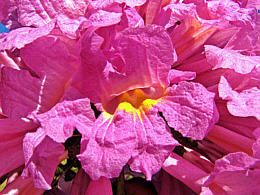
 To U.S. Users: To U.S. Users: This product
have not been evaluated by the U.S. Food & Drug Administration.
It is not intended to diagnose, treat, cure, or prevent any disease.
|
 Recent Studies on Pau d'Arco
Recent Studies on Pau d'Arco
Sourced from PubMed
 Disclaimer: The following citations provide findings on the
properties of Pau d'Arco and offer insights into prospective areas of future research.
These findings should not be inferred to provide the basis of medicinal claims,
nor should they be relied upon by the public, as such. Readers who want full access to
the PubMed database are encouraged to
register with NCBI. Disclaimer: The following citations provide findings on the
properties of Pau d'Arco and offer insights into prospective areas of future research.
These findings should not be inferred to provide the basis of medicinal claims,
nor should they be relied upon by the public, as such. Readers who want full access to
the PubMed database are encouraged to
register with NCBI.
 As of Jan. 2017, there were 165 citations posted on Pau d'Arco.
Below we list a few of the more notable: As of Jan. 2017, there were 165 citations posted on Pau d'Arco.
Below we list a few of the more notable:
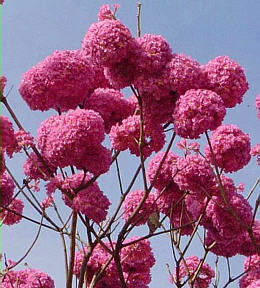
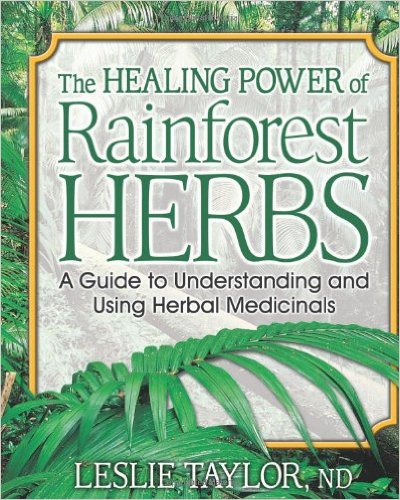
 Extensive information about
Pau d'Arco is covered on the Raintree Forest website.
Even better, you can purchase Leslie Taylor's excellent reference book,
The Healing Power
of Rainforest Herbs: A Guide to Understanding and Using Herbal Medicinals at Amazon. Extensive information about
Pau d'Arco is covered on the Raintree Forest website.
Even better, you can purchase Leslie Taylor's excellent reference book,
The Healing Power
of Rainforest Herbs: A Guide to Understanding and Using Herbal Medicinals at Amazon.
 Handroanthus impetiginosa is referenced in
Wikipedia,
as is the lapacho preparation. Handroanthus impetiginosa is referenced in
Wikipedia,
as is the lapacho preparation.
|





